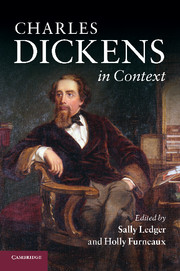Book contents
- Frontmatter
- Contents
- List of illustrations
- Notes on contributors
- Preface
- Notes on references
- PART I LIFE AND AFTERLIFE
- PART II SOCIAL AND CULTURAL CONTEXTS
- 12 Popular culture
- 13 The rise of celebrity culture
- 14 The newspaper and periodical market
- 15 Authorship and the professional writer
- 16 The theatre
- 17 Melodrama
- 18 The Bildungsroman
- 19 Visual culture
- 20 The historical novel
- 21 The illustrated novel
- 22 Christmas
- 23 Childhood
- 24 Work
- 25 Europe
- 26 The Victorians and America
- 27 Educating the Victorians
- 28 London
- 29 Politics
- 30 Political economy
- 31 The aristocracy
- 32 The middle classes
- 33 Urban migration and mobility
- 34 Financial markets and the banking system
- 35 Empires and colonies
- 36 Race
- 37 Crime
- 38 The law
- 39 Religion
- 40 Science
- 41 Transport
- 42 Illness, disease and social hygiene
- 43 Domesticity
- 44 Sexuality
- 45 Gender identities
- Further reading
- Index
16 - The theatre
Published online by Cambridge University Press: 05 August 2012
- Frontmatter
- Contents
- List of illustrations
- Notes on contributors
- Preface
- Notes on references
- PART I LIFE AND AFTERLIFE
- PART II SOCIAL AND CULTURAL CONTEXTS
- 12 Popular culture
- 13 The rise of celebrity culture
- 14 The newspaper and periodical market
- 15 Authorship and the professional writer
- 16 The theatre
- 17 Melodrama
- 18 The Bildungsroman
- 19 Visual culture
- 20 The historical novel
- 21 The illustrated novel
- 22 Christmas
- 23 Childhood
- 24 Work
- 25 Europe
- 26 The Victorians and America
- 27 Educating the Victorians
- 28 London
- 29 Politics
- 30 Political economy
- 31 The aristocracy
- 32 The middle classes
- 33 Urban migration and mobility
- 34 Financial markets and the banking system
- 35 Empires and colonies
- 36 Race
- 37 Crime
- 38 The law
- 39 Religion
- 40 Science
- 41 Transport
- 42 Illness, disease and social hygiene
- 43 Domesticity
- 44 Sexuality
- 45 Gender identities
- Further reading
- Index
Summary
From the wafer-kneed Wopsle of Great Expectations to the gin-swilling ‘Infant Phenomenon’ of Nicholas Nickleby, Dickens's novels take frequent aim at the theatre's denizens. The frequency of references to the stage in Dickens's fiction reflects the contemporary cultural significance of the theatre and further attests to Dickens's personal theatrical interests and connections. To speak of Dickens and theatre, then, one must attend to three areas: the theatre as it appeared in Dickens's own time, as it informs his fiction, and as it intersected with his personal life.
There is, to be sure, a strongly antitheatrical prejudice in much of Dickens's writing. In ‘Private Theatres’ (Sketches by Boz, 13), Dickens catalogues the low types who operate and attend such venues: ‘dirty boys, low copying clerks … shop-boys … and a choice miscellany of idle vagabonds. The proprietor of a private theatre may be an ex-scene painter, a low coffee-house keeper, a disappointed eighth-rate actor, a retired smuggler, or uncertified bankrupt.’ If we add to this list the ‘pale, dissipated-looking creatures’ he discovers lounging about Astley's stage doors (Sketches by Boz, 11) or the ‘habitual drunkard[s]’ and ‘host of shabby, poverty-stricken men’ with whom he populates the sets of Christmas pantomimes (Pickwick Papers, ch. 4), we might conclude that Dickens held a singular disdain for the theatre. And yet such an assessment would seem hasty if we were to consider Dickens's close relationships with actors, or his avid theatre-going, or his own playwriting and acting efforts.
- Type
- Chapter
- Information
- Charles Dickens in Context , pp. 125 - 132Publisher: Cambridge University PressPrint publication year: 2011
- 1
- Cited by

